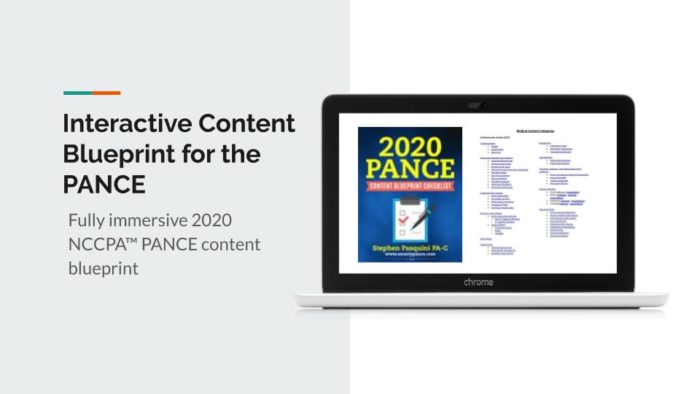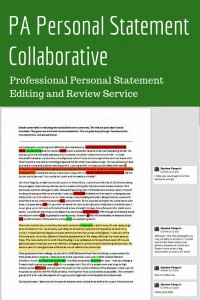 Welcome to episode 85 of the Audio PANCE and PANRE PA Board Review Podcast.
Welcome to episode 85 of the Audio PANCE and PANRE PA Board Review Podcast.
Join me as I cover ten PANCE and PANRE Board review questions from the SMARTYPANCE course content following the NCCPA™ content blueprint (download the FREE cheat sheet).
Special from today's episode:
- Download your copy of the Free Trello Smarty PANCE NCCPA™ Blueprint Study Plan
- Follow The Daily PANCE Blueprint on Instagram
- Follow The Daily PANCE Blueprint on Facebook
This week we will be covering ten general board review questions based on the NCCPA PANCE and PANRE Content Blueprints.
Below you will find an interactive exam to complement the podcast.
Below you will find an interactive exam to complement the podcast.
The Audio PANCE/PANRE and EOR PA Board Review Podcast
I hope you enjoy this free audio component to the examination portion of this site. The full board review course includes over 2,000 interactive board review questions and is available to all members of the PANCE and PANRE Academy and Smarty PANCE.
- You can download and listen to past FREE episodes here, on iTunes, on Google Play Music or Stitcher Radio.
- You can listen to the latest episode, take an interactive quiz, and download more resources below.
Listen Carefully Then Take The Practice Exam
If you can't see the audio player click here to listen to the full episode.
Podcast Episode 85: Ten MIXED PANCE and PANRE Board Review Questions
The following questions are linked to NCCPA Content Blueprint lessons from the Smarty PANCE and PANRE Board Review Website. If you are a member, you will be able to log in and view this interactive video lesson.
1. A 14-hour-old boy has failed to pass stool and is vomiting greenish fluid. He was born at 40 weeks gestation with no complications during delivery or pregnancy. His temperature is 97.6°F (36.4°C), blood pressure is 64/34 mmHg, pulse is 140/min, respirations are 33/min, and oxygen saturation is 98% on room air. The child is currently breastfeeding and appears irritable. Physical exam is notable for a distended and non-tender abdomen. The rectal exam is unremarkable. An abdominal radiograph demonstrates distended loops of bowel. What is the most likely diagnosis?
- Cystic fibrosis
- Hirschsprung disease
- Jejunal atresia
- Pyloric stenosis
- Tracheoesophageal fistula
2. A 34-year-old female presents to her ophthalmologist with 6 hours of blurry vision in her right eye. She reports severe pain with eye movement that has not been relieved with NSAIDs. She feels that she has been generally healthy all her life, although she does note one week of right arm weakness during the previous year that resolved without treatment. On exam, she has no noted ocular secretions. On her fundal exam, you note blurred borders on the optic disc. Which of the following additional findings is likely to be present in this patient?
- Polycythemia
- Elevated IgG in the cerebrospinal fluid (CSF)
- Multiple areas of periventricular hyperintensity on T2 FLAIR imaging
- Subdural hematoma
- Small, punctate hypointensities on gradient-echo MR
3. A 43-year-old man is brought to the emergency department after having a seizure. His wife states that the patient has been struggling with alcohol abuse and has recently decided to "quit once and for all". Physical exam is notable for a malnourished patient responsive to verbal stimuli. He has moderate extremity weakness, occasional palpitations, and brisk deep tendon reflexes (DTRs). EKG demonstrates normal sinus rhythm and a prolonged QT interval. What nutritional deficiency most likely contributed to these findings?
- Potassium
- Calcium
- Folate
- Magnesium
- Vitamin D
4. A 17-year-old female presents to her physician’s office after noticing a round lump in her left breast 2 months ago. She reports that the lump seemed to enlarge and became tender just preceding her last 2 menses. It is otherwise painless, and the patient denies any discharge or skin changes. She has no past medical history but her grandmother, age 72, was just diagnosed with invasive ductal carcinoma of the breast. The patient is an avid softball player at her high school and denies alcohol, smoking, or illicit drug use. On exam, the breasts appear symmetric and normal. A 3-cm round, mobile mass is palpated in the upper outer quadrant of the left breast. There is slight tenderness to deep palpation of the mass. There is no axillary lymphadenopathy on either side. Which of the following is the most likely outcome of this patient’s condition?
- This mass will likely require excision
- This mass will decrease in size if the patient starts oral contraceptives
- This mass slightly increases this patient’s risk of breast cancer in the future
- This mass will most likely decrease in size or disappear over time
- If this mass grows rapidly to greater than 5 cm, radiation and chemotherapy are indicated
5. A 26-year-old monogamous female presents with cyclic pelvic pain that has been increasing over the last 6 months. She complains of significant dysmenorrhea and dyspareunia. She uses condoms for birth control. On physical examination, her uterus is retroverted and non-mobile, and she has a palpable adnexal mass on the left side. Her serum pregnancy test is negative. Which of the following is the most likely diagnosis?
- Ovarian cancer
- Endometriosis
- Functional ovarian cyst
- Pelvic inflammatory disease
6. A healthy 29-year-old woman at 30-weeks gestational age has gained 35lbs since becoming pregnant. She complains of several weeks of bilateral numbness and tingling of her palms, thumbs, index, and middle fingers that is worse at night. She also notes weakness gripping objects at the office. Which nerve is most likely affected?
- Median nerve
- Ulnar nerve
- Radial nerve
- Axillary nerve
- Anterior interosseous nerve
7. A 55-year-old female comes to the ED complaining of moderate right eye pain, headache, and acute onset of blurry vision, which she describes as colored halos around lights. She was watching a movie at home with her husband about an hour ago when the pain began. On the physical exam of her right eye, her pupil is mid-dilated and unresponsive to light. Her right eyeball is firm to pressure. Intraocular pressure (IOP) measured with a tonometer is elevated at 36mmHg. Which of the following is the most appropriate emergency treatment?
- Timolol ophthalmic solution
- Epinephrine ophthalmic solution
- Laser peripheral iridotomy
- Anti-cholinergic ophthalmic solution
- NSAID ophthalmic solution
8. A 68-year-old woman presents to your office for her annual check-up. Her vitals are HR 85, T 98.8 F, RR 16, BP 125/70. She has a history of smoking 1 pack a day for 35 years but states she quit five years ago. She had her last pap smear at age 64 and states all of her pap smears have been normal. She had her last colonoscopy at age 62, which was also normal. Which is the following is the next best test for this patient?
- Abdominal ultrasound
- Chest CT scan
- Pap smear
- Colonoscopy
- Chest radiograph
9. A 22-year-old man presents to the emergency room complaining of pain upon urination and a watery discharge from his penis. It started a few days ago and has been getting progressively worse. His temperature is 98.0°F (36.7°C), blood pressure is 122/74 mmHg, pulse is 83/min, respirations are 14/min, and oxygen saturation is 98% on room air. Physical exam is notable for a tender urethra with discharge. Gram stain of the discharge is negative for bacteria but shows many neutrophils. Which of the following is the most likely infectious etiology of this patient's symptoms?
- Chlamydia trachomatis
- Escherichia coli
- Neisseria gonorrhoeae
- Staphylococcus saprophyticus
- Trichomonas vaginalis
10. A 6-year-old boy is admitted with a one-week history of diarrhea, which was sometimes bloody and originally began after a birthday party. He has become lethargic and has not been eating or drinking. His vital signs are as follows: T 38.5 C, HR 135, BP 82/54. Physical examination is significant for petechiae on his legs and diffuse abdominal tenderness to palpation. Lab-work shows BUN 72 mg/dL, creatinine 8.1 mg/dL, and platelet count < 10,000. PT and PTT are within normal limits. Which of the following would be expected on a peripheral blood smear?
- Rouleaux formation
- Fragmented red blood cells
- Spur cells
- Giant platelets
- No abnormalities
Looking for all the podcast episodes?
This FREE podcast series is limited to every other episode, you can download and enjoy the complete audio series by becoming a Smarty PANCE member.
I will be releasing new episodes every few weeks. Smarty PANCE is now discounted, so sign up now before it's too late!
Resources and Links From The Show
- Check out the new EOR, PANCE, PANRE search and study tool
- My list of recommended PANCE and PANRE review books
- Interactive PANCE and PANRE NCCPA Exam Content Blueprints
- Sign up for the FREE Daily PANCE and PANRE email series
- Join the Smarty PANCE NCCPA Content Blueprint Website
- Get your free Trello PANCE study schedule
- Get 20% of any Picmonic membership by using this link
- Follow Smarty PANCE and The Daily PANCE Blueprint on Instagram
- Follow Smarty PANCE and The Daily PANCE Blueprint on Facebook
This Podcast is also available on iOS and Android
- iTunes: The Audio PANCE and PANRE Podcast iTunes
- Stitcher Radio: The Audio PANCE and PANRE Podcast Stitcher
- Google Play: The Audio PANCE and PANRE Podcast Google Play
Download The Content Blueprint Checklist
Follow this link to download your FREE copy of the PANCE Content Blueprint Checklist
Print it up and start crossing out the topics you understand, marking the ones you don't, and making notes of key terms you should remember. The PDF version is interactive and linked directly to the individual lessons on Smarty PANCE.
Download for PANCE Download for PANRE
Podcast: Download (18.8MB) | Embed
Subscribe: Email | RSS | PANCE and PANRE Podcast Player
View all posts in this series
- The Audio PANCE and PANRE Board Review Podcast Episode 1
- The Audio PANCE and PANRE Board Review Podcast Episode 3
- The Audio PANCE and PANRE Board Review Podcast Episode 5
- The Audio PANCE and PANRE Board Review Podcast Episode 7
- The Audio PANCE and PANRE Board Review Podcast Episode 9
- The Audio PANCE and PANRE Board Review Podcast Episode 11
- The Audio PANCE and PANRE Board Review Podcast Episode 13
- The Audio PANCE and PANRE Board Review Podcast Episode 15
- The Audio PANCE and PANRE Board Review Podcast Episode 17
- The Audio PANCE and PANRE Board Review Podcast Episode 19
- The Audio PANCE and PANRE Board Review Podcast Episode 21
- The Audio PANCE and PANRE Board Review Podcast Episode 23
- The Audio PANCE and PANRE Board Review Podcast Episode 25
- Cardiology 1: The Audio PANCE and PANRE Podcast Topic Specific Review Episode 27
- Pulmonology 1: The Audio PANCE and PANRE Podcast Topic Specific Review Episode 29
- Gastroenterology 1: The Audio PANCE and PANRE Podcast Topic Specific Review Episode 31
- EENT 1: The Audio PANCE and PANRE Board Review Podcast Topic Specific Review Episode 33
- Genitourinary 1: The Audio PANCE and PANRE Board Review Podcast Topic Specific Review Episode 35
- Musculoskeletal 1: The Audio PANCE and PANRE Board Review Podcast Topic Specific Review Episode 37
- Reproductive System 1: The Audio PANCE and PANRE Board Review Podcast Topic Specific Review Episode 39
- Episode 41: The Audio PANCE and PANRE Board Review Podcast
- Episode 43: The Audio PANCE and PANRE Board Review Podcast
- Murmur Madness: The Audio PANCE and PANRE Episode 45
- Episode 47: The Audio PANCE and PANRE Board Review Podcast – Comprehensive Audio Quiz
- Episode 49: The Audio PANCE and PANRE Board Review Podcast – Comprehensive Audio Quiz
- Episode 51: The Audio PANCE and PANRE Board Review Podcast – Comprehensive Audio Quiz
- Episode 53: General Surgery End of Rotation Exam – The Audio PANCE and PANRE Podcast
- Episode 55: The Audio PANCE and PANRE Board Review Podcast
- Episode 57: The Audio PANCE and PANRE Board Review Podcast
- Episode 59: Emergency Medicine EOR – The Audio PANCE and PANRE Board Review Podcast
- Episode 61: The Audio PANCE and PANRE Board Review Podcast
- Episode 63: The Audio PANCE and PANRE PA Board Review Podcast
- Podcast Episode 65: Hepatitis B Breakdown With Joe Gilboy PA-C
- Podcast Episode 67: Ten PANCE and PANRE Board Review Audio Questions
- Podcast Episode 69: Ten PANCE and PANRE Board Review Audio Questions
- Podcast Episode 71: Ten PANCE and PANRE Board Review Audio Questions
- Podcast Episode 73: Ten FREE PANCE and PANRE Audio Board Review Questions
- Podcast Episode 75: Ten FREE PANCE and PANRE Audio Board Review Questions
- Podcast Episode 77: The Audio PANCE and PANRE Board Review Podcast
- How to Study for Your PANCE: Podcast Episode 79
- Podcast Episode 81: Internal Medicine EOR Cardiology Questions
- How to Answer the Hardest PANCE and PANRE Test Questions: Podcast Episode 82
- How to Answer Tricky PANCE and PANRE Test Questions Part 2: Podcast Episode 83
- Cardiac Pharmacology Part One: The Audio PANCE and PANRE Episode 84
- Podcast Episode 85: Ten Mixed Multiple Choice Questions
- How to Be a Better PA Part 1: Nurses, Lab Techs, and X-Ray Technicians
- Podcast Episode 87: Ten Internal Medicine EOR Questions
- How to Be a Better PA Part 2: Medical Staff, Administrators, and Supervisors
- Podcast Episode 89: Ten PANCE, PANRE, and Rotation Review Questions
- Podcast Episode 90: Ten PANCE, PANRE, and Rotation Review Questions

















Leave a Reply